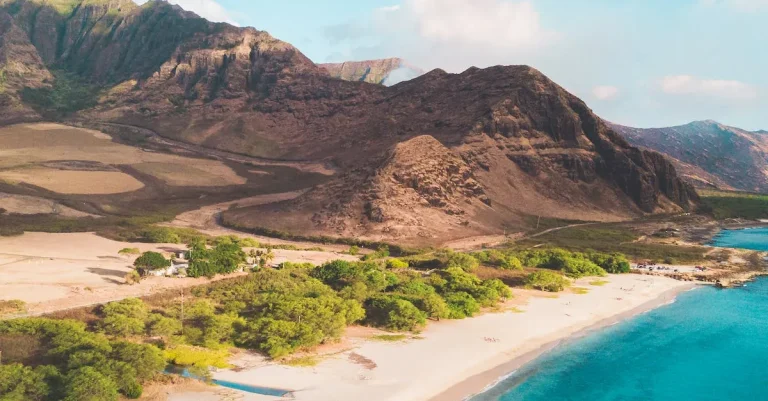Save money on your next flight
Skyscanner is the world’s leading flight search engine, helping you find the cheapest flights to destinations all over the world.
With its pristine beaches, lush rainforests, and active volcanoes, Hawaii is one of the most stunning places on Earth. But could this paradise someday slip beneath the sea?
If you’re short on time, here’s a quick answer: While some areas of the Hawaiian Islands are gradually subsiding, Hawaii as a whole is not in danger of sinking anytime soon.
In this comprehensive article, we’ll take an in-depth look at the unique geology of Hawaii to understand what’s causing localized sinking in some regions and explore whether the islands face any risk of disappearing under the Pacific in the future.
We’ll examine the evidence, causes, and rates of subsidence around Hawaii as well as projections for sea level rise in the coming decades and centuries to shed light on this pressing question.
An Introduction to the Geology of Hawaii
Hawaii is a unique and fascinating place, not only for its stunning natural beauty but also for its geological history. The Hawaiian Islands are a result of volcanic activity, and their formation is closely tied to the movement of tectonic plates.
In this article, we will explore the geology of Hawaii, including the formation of the islands and the ongoing processes that shape their landscape.
The Hawaiian Hot Spot
The Hawaiian Islands owe their existence to a phenomenon known as a hot spot. Deep beneath the Earth’s surface, a plume of hot molten rock, or magma, rises from the mantle.
This plume, known as the Hawaiian hot spot, has remained relatively stationary over millions of years while the Pacific tectonic plate moves slowly northwest. As the plate moves, it carries the volcanoes formed by the hot spot along with it, creating a chain of islands.
Fun Fact: Did you know that the Hawaiian hot spot is responsible for more than just the Hawaiian Islands? It has also created other volcanic features, such as seamounts and atolls, stretching all the way to the Aleutian Islands in Alaska!
How the Islands Formed
The formation of the Hawaiian Islands is a result of repeated volcanic activity. Each island in the chain represents a different stage in the life cycle of a volcano.
The youngest and most active volcano is located at the southeastern end of the chain, while the oldest and most eroded volcano is found at the northwestern end.
Fun Fact: The Big Island of Hawaii is home to the famous Mauna Loa and Kilauea volcanoes. Mauna Loa is one of the largest volcanoes on Earth and is still considered an active volcano.
Kilauea, on the other hand, is one of the world’s most active volcanoes, with frequent eruptions that have shaped the island’s landscape.
Ongoing Erosion and Subsidence
While the Hawaiian Islands continue to be shaped by volcanic activity, they are also subject to erosion and subsidence.
The constant exposure to wind, waves, and rain slowly wears down the volcanic rock, creating stunning cliffs, valleys, and beaches.Additionally, as the weight of the islands pushes down on the underlying crust, it causes the land to gradually sink, a process known as subsidence.
Interesting Fact: The erosion of the Hawaiian Islands has led to the formation of some truly remarkable natural features. For example, the Na Pali Coast on the island of Kauai is renowned for its stunning sea cliffs that rise dramatically from the ocean.
Observations of Land Subsidence in Hawaii
Land subsidence, or the sinking of land, is a natural process that occurs in various parts of the world, including Hawaii. The islands of Hawaii are formed by volcanic activity, which creates a unique geological environment.
Over time, the weight of the volcanic islands can cause the underlying crust to slowly sink or settle. This subsidence can be observed in different areas of the Hawaiian Islands, including Oahu, Maui, and the Big Island.
Subsidence on Oahu
Oahu, the most populated island in Hawaii, has experienced land subsidence in certain areas. The city of Honolulu, located on the southern coast of Oahu, has seen some subsidence due to both natural and human-induced factors.
Factors such as groundwater extraction, development, and changes in the underlying geological structures can contribute to land subsidence. In some areas of Oahu, subsidence rates have been measured to be a few millimeters per year.
Sinking Areas on Maui
Maui, the second-largest island in Hawaii, also exhibits land subsidence in certain regions. The town of Kahului on the northern coast of Maui has experienced subsidence due to various factors, including groundwater extraction for agricultural purposes.
Other areas on the island, such as Lahaina and Kihei, have also shown signs of subsidence. Although the rates of subsidence on Maui may be relatively low, they can still have significant impacts on infrastructure and coastal ecosystems.
The Big Island’s Hilo Bay
The Big Island of Hawaii, known for its active volcanoes and diverse landscapes, has observed land subsidence in specific areas, including Hilo Bay. Subsidence in Hilo Bay has been attributed to both volcanic activity and the weight of the island.
The subsidence can result in changes in the coastline and affect the stability of structures in the area. Monitoring and understanding the subsidence patterns in Hilo Bay are crucial for ensuring the safety and sustainability of the local community.
Understanding the observations of land subsidence in Hawaii is essential for managing the risks associated with this geological phenomenon.
Scientists and researchers continuously monitor and study the subsidence patterns using various techniques such as satellite imagery, ground-based surveys, and GPS measurements.
By better understanding the factors contributing to land subsidence, we can develop strategies to mitigate its effects and ensure the long-term stability and sustainability of the Hawaiian Islands.
Causes of Localized Subsidence
Plate Tectonics
Plate tectonics play a significant role in the subsidence of the Hawaiian Islands. The islands are located in the middle of the Pacific Plate, which is slowly moving northwest. As the Pacific Plate moves, it carries the islands with it.
However, as the islands move away from the hotspot that initially formed them, they begin to cool and sink. This process, known as isostatic subsidence, is a natural occurrence that happens to all volcanic islands over time.
Volcanic Processes
The volcanic activity in Hawaii is another contributing factor to the localized subsidence.
The islands are formed by a hotspot, where magma rises to the surface and creates new land. However, as the lava cools and solidifies, it adds weight to the island, causing it to sink further into the ocean.
This process is known as volcanic loading and is a continuous cycle of eruption, cooling, and sinking. While new land is being created, the older parts of the islands are gradually sinking.
Human Activities
While natural processes are the primary causes of localized subsidence in Hawaii, human activities can also contribute to this phenomenon.
Groundwater extraction and the pumping of fluids from underground reservoirs can lead to the compaction of sediments, resulting in land subsidence.
Additionally, the construction of large buildings and infrastructure can put added weight on the land, causing it to sink. It is crucial for humans to be mindful of their activities and take necessary measures to mitigate the potential impact on the island’s geology.
For more information on the geology of the Hawaiian Islands, you can visit the United States Geological Survey’s website at www.usgs.gov. They provide extensive research and data on the geological processes and history of the islands.
Will Hawaii Sink Under the Ocean?
Hawaii is commonly associated with picturesque beaches, stunning landscapes, and a tropical paradise.
However, there is a longstanding question that has intrigued scientists and locals alike: will Hawaii eventually sink under the ocean? Let’s take an in-depth look at the geology of the Hawaiian Islands to find out.
Projected Sea Level Rise
With the ongoing concern of climate change and rising sea levels, it is natural to wonder if Hawaii is at risk.
According to studies conducted by the Intergovernmental Panel on Climate Change (IPCC), global sea levels are projected to rise by an average of 0.3 to 1 meter by the end of the century.
While this may seem alarming, it is important to note that the islands of Hawaii are not expected to be completely submerged.
The topography of Hawaii plays a crucial role in mitigating the potential impact of rising sea levels. The islands are formed by volcanic activity, resulting in steep slopes and rugged coastlines.
These natural features provide a natural defense against the encroaching ocean, minimizing the risk of complete submergence.
Countering Forces of Uplift
In addition to the threat of rising sea levels, there is a counteracting force at play in the geology of Hawaii: uplift.
The Hawaiian Islands are located in the middle of the Pacific Plate, which is constantly moving in a northwesterly direction. As the plate moves, it encounters resistance from the underlying mantle, causing the islands to rise.
This process, known as isostatic rebound, helps to counteract the potential sinking effect of rising sea levels. As the islands continue to experience uplift, they are able to maintain their position above the water surface.
However, it is important to note that this uplift is a relatively slow process, occurring over thousands to millions of years.
The Future of the Islands
While Hawaii is not expected to be completely submerged in the foreseeable future, it is important to consider the long-term effects of climate change.
Rising sea levels can still have significant impacts on coastal communities, infrastructure, and ecosystems. It is crucial for policymakers and communities to develop strategies to adapt to these changes and mitigate their potential consequences.
Furthermore, ongoing research and monitoring are essential to better understand the complex interactions between sea level rise, uplift, and other geological processes.
Scientists continue to study the geology of the Hawaiian Islands to gain insights into the future of these iconic and cherished landscapes.
Read more: Is Hawaii Floating? A Detailed Look At The Geology Of The Hawaiian Islands
Conclusion
While parts of Hawaii are gradually sinking due to natural geologic processes and human activities, geology experts agree the islands as a whole are not at risk of disappearing beneath the waves anytime soon.
Active volcanism and ongoing uplift of the seafloor will likely counteract the localized subsidence occurring in some areas as well as future sea level rise from climate change.
However, low-lying coastal regions will become increasingly vulnerable to flooding and erosion in the coming decades and centuries.
Understanding the interplay between subsidence, uplift, and sea level rise around Hawaii will be key for effectively adapting to coastal hazards and preserving these magnificent islands far into the future.







